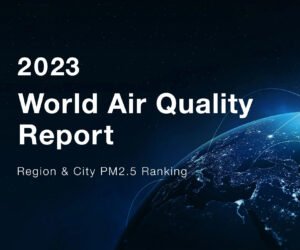
Why in news?
- The World Air Quality Report 2023 has brought to light India’s persistent struggle with air pollution, ranking it as the third most polluted country globally.
- In this comprehensive blog, we delve into the report’s key findings, health ramifications, WHO guidelines, and initiatives aimed at combating the alarming levels of air pollution plaguing the nation.
Key Highlights of the World Air Quality Report 2023:
- India’s Ranking:
- India’s air quality continues to deteriorate, with an average annual PM2.5 concentration of 54.4 micrograms per cubic meter, placing it third on the list of the most polluted countries worldwide.
- Notably, the report underscores the exacerbation of pollution levels in urban centers, with Delhi retaining its dubious distinction as the world’s most polluted capital city for the fourth consecutive year.
- Shockingly, nine out of the top ten most polluted cities globally are located in India, signifying the severity of the air quality crisis across the nation.
- Health Impacts and WHO Guidelines:
- The alarming levels of particulate matter pollution in India pose a severe threat to public health, with approximately 136 million Indians, comprising 96% of the population, exposed to PM2.5 concentrations significantly exceeding the World Health Organization’s recommended guidelines.
- The deleterious health effects of prolonged exposure to PM2.5 pollution are manifold, encompassing a heightened risk of cardiovascular diseases, respiratory ailments, and neurological disorders, thereby necessitating urgent interventions to mitigate the burgeoning health crisis.
- Global Air Quality:
- While several countries have made strides in curbing air pollution, only seven nations, including Australia, Estonia, Finland, Grenada, Iceland, Mauritius, and New Zealand, have managed to meet the WHO’s annual PM2.5 guidelines.
- However, Africa remains a glaring blind spot in global air quality monitoring efforts, with a significant portion of its population lacking access to reliable air quality data, underscoring the urgent need for enhanced data collection and dissemination initiatives across the continent.
- Global Impact of Air Pollution:
- The pernicious effects of air pollution extend far beyond national borders, with approximately seven million premature deaths attributable to poor air quality worldwide annually.
- Exposure to elevated levels of PM2.5 pollution precipitates a myriad of health complications, ranging from respiratory illnesses and cardiovascular disorders to adverse neurological outcomes and diminished cognitive function, thereby exacting a substantial toll on public health and economic productivity worldwide.
- WHO Guidelines:
- The World Health Organization periodically updates its evidence-based air quality guidelines to safeguard public health from the pervasive threat of air pollution.
- These guidelines encompass a comprehensive suite of pollutants, including particulate matter (PM10 and PM2.5), ozone (O3), nitrogen dioxide (NO2), sulfur dioxide (SO2), and carbon monoxide (CO), serving as a crucial reference point for policymakers and public health authorities in formulating effective air quality management strategies.
- Initiatives Taken for Controlling Air Pollution:
- In response to the burgeoning air quality crisis, the Indian government has instituted several initiatives aimed at mitigating air pollution levels and improving ambient air quality standards.
- These initiatives include the National Clean Air Programme (NCAP), Bharat Stage Emission Standards, Solid Waste Management Rules, System of Air Quality and Weather Forecasting and Research (SAFAR) Portal, Air Quality Index (AQI), Graded Response Action Plan, National Air Quality Monitoring Programme (NAMP), and the establishment of the Commission for Air Quality Management, underscoring the multi-faceted approach adopted by policymakers to address the multifarious challenges posed by air pollution.
- Way Forward:
- Addressing India’s air quality crisis necessitates a concerted and multi-pronged approach encompassing regulatory strengthening, transition to clean energy alternatives, industrial improvements, public awareness campaigns, investment in research and innovation, and enhanced international cooperation.
- By prioritizing air quality management as a collective responsibility and embracing sustainable and equitable solutions, India can chart a path towards cleaner, healthier, and more sustainable urban environments for present and future generations.
People also ask
Q1: What is air pollution, and why is it a concern in India?
Ans: Air pollution refers to the presence of harmful or excessive quantities of substances in the air, such as particulate matter, nitrogen dioxide, sulfur dioxide, ozone, and carbon monoxide. In India, air pollution has become a significant concern due to its adverse effects on public health, the environment, and economic productivity.
Q2: What are the major sources of air pollution in India?
Ans: Major sources of air pollution in India include vehicular emissions, industrial activities, construction and demolition, biomass burning, agricultural practices, and household cooking and heating using solid fuels. These activities release pollutants such as particulate matter, nitrogen oxides, sulfur dioxide, volatile organic compounds, and carbon monoxide into the atmosphere.
Q3: What are the health impacts of air pollution?
Ans: Air pollution can have severe health consequences, including respiratory diseases (such as asthma, bronchitis, and chronic obstructive pulmonary disease), cardiovascular diseases, neurological disorders, and adverse reproductive outcomes. Prolonged exposure to air pollution is also associated with increased mortality rates and reduced life expectancy.
Your article helped me a lot, is there any more related content? Thanks!
Your article helped me a lot, is there any more related content? Thanks!